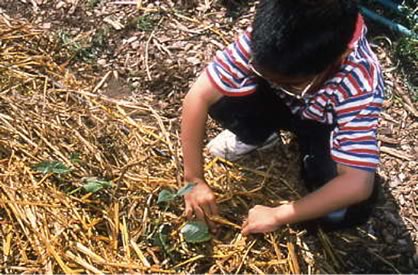Gardens may benefit from having 1 to 4 inches of mulch applied on top of the soil around established plants. Keep the mulch a few inches away from plant stems to avoid disease problems. Mulching:
-
- Offers an efficient means of conserving moisture and controlling weeds.
- Helps slow water loss by evaporation.
- Moderates the temperature of the soil.
- Decreases the spread of certain diseases.
- Deprives weeds of the sunlight they need to germinate and grow.
- May provide a favorable habitat for sow bugs, earwigs, slugs and other pests.
Examples of organic mulches are weathered sawdust, compost, straw, bark chips, or other such materials that you know have not been contaminated with harmful chemicals or weed seed.

Organic mulches with a high carbon content and small particle size, such as raw sawdust, may remove some nitrogen from surface soil, leaving less for plant roots to absorb. This can be prevented by applying about 2 pounds of a nitrogen fertilizer (such as ammonium sulfate) per 100 square feet prior to mulching. This will ensure that adequate nitrogen will be available to both the mulch and crops. If the ammonium sulfate is applied on top of the mulch, much of the beneficial nitrogen will dissipate into the air. Organic mulches can be tilled under periodically to improve the condition of the soil.
You can also shred yard trimmings as finely as possible, spread them over the soil, around plants, and allow it to decompose on the surface. Do not work this material into the soil until it has decomposed because nitrogen will be drawn from the soil by the process of breaking down the mulch. If raw mulch that has a high carbon content and little nitrogen is worked into the soil, it will be necessary to add nitrogen at the same time. When using grass clippings for mulch apply a thin layer and let them dry before applying more, to discourage flies from laying eggs in a thick layer of moist clippings. Do not use Bermuda grass clippings as they will root and grow.
Inorganic materials such as black plastic film and weed-block fabric can also serve as mulches. Use metal or plastic pins, rocks or boards to hold them in place. They provide the same benefits as organic mulches, but they do not offer the soil conditioning potential of the organics. Black plastic and weed-block fabric can be placed on the soil and properly anchored against wind immediately after the soil is prepared for planting. Set transplants through the plastic or fabric by cutting holes just large enough for the plant to fit through. This method works best with widely spaced plants, such as squash, cucumbers, melons and tomatoes. Place a soaker hose or a drip emitter on the ground, under the mulch, to facilitate irrigation. Plastic mulches will break down more quickly from exposure to direct sun unless they are covered with a layer of straw, bark chips or other organic matter. Gardens with dirt pathways can use inorganic mulch such as weed-block fabric to help control weed growth and mud in the paths.
Array